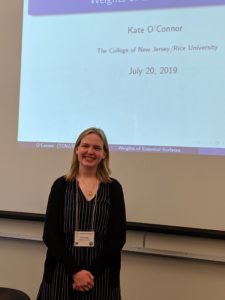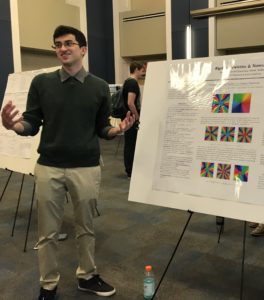 The Mathematics and Statistics Department offers majors the opportunity to earn departmental honors through the completion of advanced, in-depth study and research within mathematics and statistics. Students work with a faculty mentor on a research problem over the course of at least one-semester, and often a year. Students will sign up for either MAT or STA 493 (these courses are in addition to the majors’ normal 400-level requirements) each semester they are working on the project, and will present a public research talk based upon a paper at its conclusion. The official requirements are listed at the bottom of this page. Please note that department honors are not connected to graduation honors (e.g. summa cum laude) that are based upon the overall college GPA, or TCNJ’s Honors Program.
The Mathematics and Statistics Department offers majors the opportunity to earn departmental honors through the completion of advanced, in-depth study and research within mathematics and statistics. Students work with a faculty mentor on a research problem over the course of at least one-semester, and often a year. Students will sign up for either MAT or STA 493 (these courses are in addition to the majors’ normal 400-level requirements) each semester they are working on the project, and will present a public research talk based upon a paper at its conclusion. The official requirements are listed at the bottom of this page. Please note that department honors are not connected to graduation honors (e.g. summa cum laude) that are based upon the overall college GPA, or TCNJ’s Honors Program.
 Students interested in earning departmental honors should attend the public Honors talks that are given in the department (usually each year at the end of the Spring semester) and to contact faculty about possible research projects. All department faculty welcome students to work with them on research problems. Some more specific information about specific interests can be found on the undergraduate research page. Students are encouraged to contact Professor Hagedorn, the department’s honors coordinator, if they would like more information.
Students interested in earning departmental honors should attend the public Honors talks that are given in the department (usually each year at the end of the Spring semester) and to contact faculty about possible research projects. All department faculty welcome students to work with them on research problems. Some more specific information about specific interests can be found on the undergraduate research page. Students are encouraged to contact Professor Hagedorn, the department’s honors coordinator, if they would like more information.
List of recent honors students, research project titles and advisors
| Student | Title | Advisor | Area |
| Kendra Ebke ’23 | Analyzing Macroscopic Behaviors of Heterogeneous Communities of Neurons | Matt Mizuhara | Mathematical Biology |
| Jack Ramina ’23 | Covering System of the Gaussian Integers Z[i] | Tom Hagedorn | Number Theory |
| Robert Rust ’23 | A Bound for Higher Degree Automorphisms of F_n | Andrew Clifford | Algebra (Group Theory) |
|
|
|||
|
|
|||
| Tierney Baldwin ’21 |
Sifting through Siphonophore Swimming: Studying Nectophore Offset Synchronizations
|
Nicholas Battista | Mathematical Biology |
| Joseph Ingenito ’21 |
On the 2nd Order Kuramoto Model of Coupled Oscillators
|
Matt Mizuhara | Applied Mathematics |
| Michael Luo ’21 |
Using Nonlinear Mixed Effects to Optimize a Model of Immunotherapy-Treated Murine Melanaoma
|
Jana Gevertz | Mathematical Biology |
|
|
|||
| Peter Tonuzi ’20 |
State Polynomials of Periodic Knots and Quotient Knots
|
Cynthia Curtis | Topology (Knot Theory) |
| Nicholas Bolle ’19 |
Investigating A Proposed Wedge Power for Matroids
|
Steffen Marcus | Algebra (Matroid Theory) |
| Sebastian Calvo ’19 |
Projection Monoid Schemes and Extended Fans
|
Steffen Marcus | Algebra (Matroid Theory) |
| Danielle Demateis ’19 |
Non-Negative Matrix Factorization for Rank Normalized Data
|
Michael Ochs | Statistics |
| Melanie Loth ’19 |
Identifying Underlying Patterns in Animal Images Using Non-Negative Matrix Factorization
|
Michael Ochs | Statistics (Pattern Formation) |
| Kate O’Connor ’19 | Weights of Essential Surfaces | Cynthia Curtis | Topology (Knot and Surface Theory) |
| Lisha Silver ’19 |
A Differential Equations Model on the Effects of Gender and Pedagogy on Math Anxiety
|
Matt Mizuhara | Mathematical Modeling |
| Sharon Ling ’18 |
Exploring the Role of Genetics in Obesity
|
Michael Ochs | Statistics |
| Ethan Crasto ’18 |
Examining Competing Risks of STEM Attrition at TCNJ
|
David Holleran | Statistics |
| Alina Kuvelkar ’18 |
Exploring Biomolecular Drivers of Pathway Activity in Head and Neck Squamous Cell Carcinoma Using Structural Equation Modeling
|
Michael Ochs | Statistics |
| Rebecca Santorella ’17 |
A Multiscale Model of Tumor Growth in Response to Stochastic Signaling Networks
|
Jana Gevertz and Michael Ochs | Mathematical Biology |
| Cory Weinfeld ’17 |
Bases of Free Groups with Small Rank
|
Andrew Clifford | Algebra (Group Theory) |
| Elizabeth Eisenhauer ’17 |
Structural Equation Modeling of Cell Signaling Networks in Head and Neck Squamous Cell Carcinoma
|
Michael Ochs | Statistics |
| Benjamin Castor ’16 |
Equations Over Groups Containing Elements of Order Two
|
Andrew Clifford | Algebra (Group Theory) |
| Paloma Hauser ’16 | Michael Ochs | Statistics | |
| Alana Huszar ’16 |
Pointed Monoids and Extended Rational Polyhedral Cones
|
Steffen Marcus | Algebra (Matroid Theory) |
| Joseph Ruffo ’15 |
Fixed Subgroups of Finitely Generated Free Group Automorphisms
|
Andrew Clifford | Algebra (Group Theory) |
| Conor Kelton ’15 |
Non-negative Matrix Factorization and the Estimation of Dimensionality in Gene Expression
|
Michael Ochs | Statistics |
| Vincent Longo ’15 |
Knot Invariants of Non-Orientable Essential Surfaces
|
Cynthia Curtis | Topology (Knot and Surface Theory) |
| Michael Muller ’14 | Automorphisms of Finitely Generated Free Groups | Andrew Clifford | Algebra (Group Theory) |
| Mary Ambrosino ’12 |
Mod 2 Rank of 1-Relator Group
|
Andrew Clifford | Algebra (Group Theory) |
| Edward Lee ’12 |
Mathematical Modeling of Chemical Kinetics in Pregnant and Lactating Rats
|
Leona Harris | Mathematical Biology |
| Glen Wilson ’10 | Adjoint Functors | Carlos Alves | Category Theory |
| Samuel Taylor ’09 |
Incompressible Surfaces in Alternating Knot Complements
|
Cynthia Curtis | Topology (Knot and Surface Theory) |
| Jeff Hatley ’09 |
On the Rank of the Elliptic Curve y^2 = x(x − p)(x − 2)
|
Tom Hagedorn | Number Theory |
| Matt Luther ’09 | Cynthia Curtis | Topology (Knot and Surface Theory) | |
| Michael Stein ’08 | Plant-Pathogen Dynamics | Jean-Michel Jean-Michelet | Mathematical Biology |
| Janet Morrison | |||
| Brendan Kelly ’08 | Jean-Michel Jean-Michelet | ||
| Vincent Martinez ’08 | Jean-Michel Jean-Michelet | ||
| Sarah Frack ’08 | Cynthia Curtis |
Official Requirements for Honors for all majors and specializations within the Department of Mathematics and Statistics:
- Eligibility: A 3.5 GPA in math and statistics courses.
- To receive departmental honors, a student must engage in independent research during their junior or senior year. The student should successfully complete an Independent Research 493 course during a semester they spend on-campus, and prepare a paper which will be due the middle of their last (graduating) term. A presentation (which we envision being a 40 minute talk, perhaps during a lunch period) will be given in the two week period following the submission of the paper. The members of the student’s Honors Committee will be present, and be given ample opportunity to ask the students questions about their research to gauge their level of understanding.
